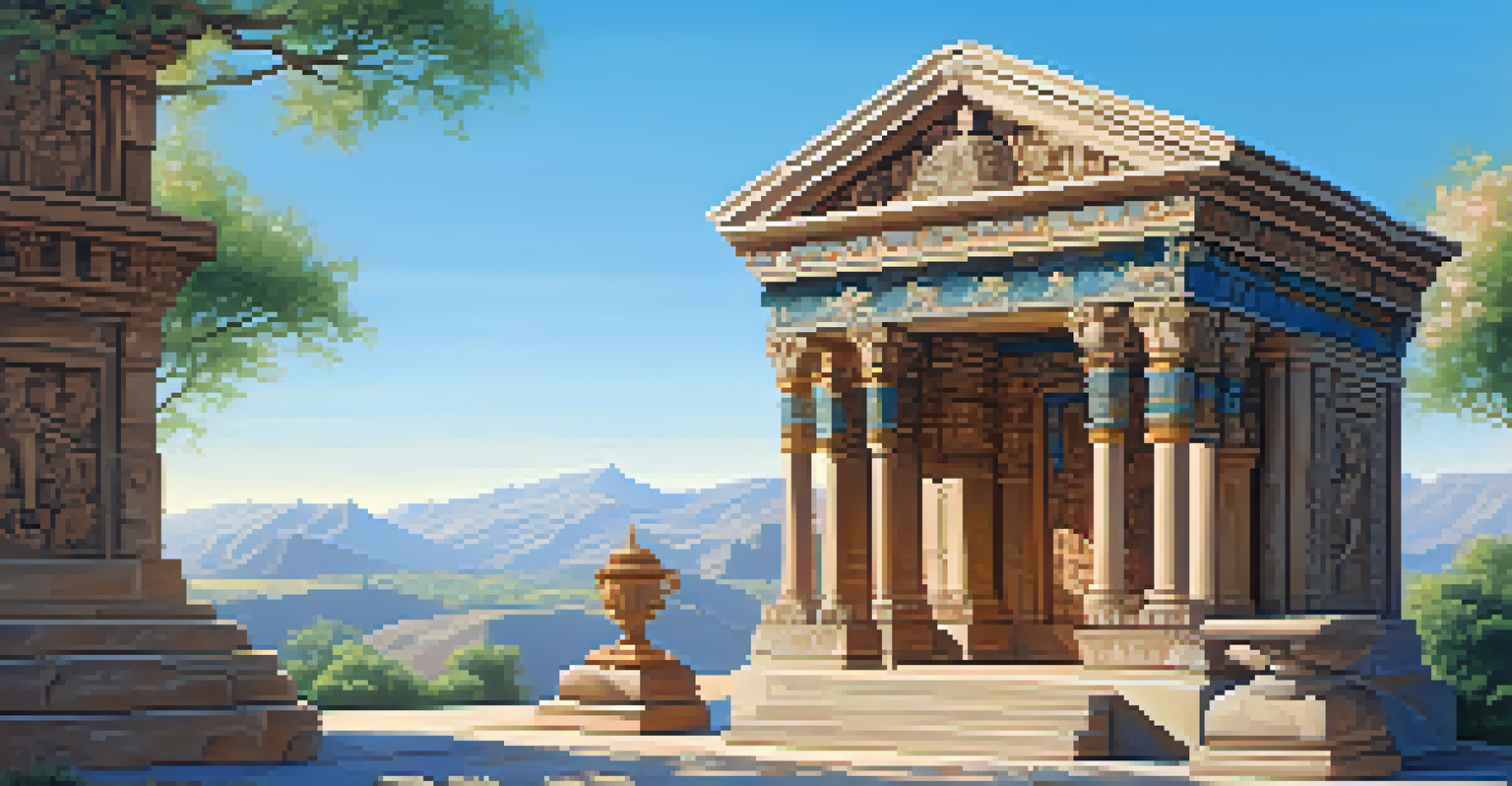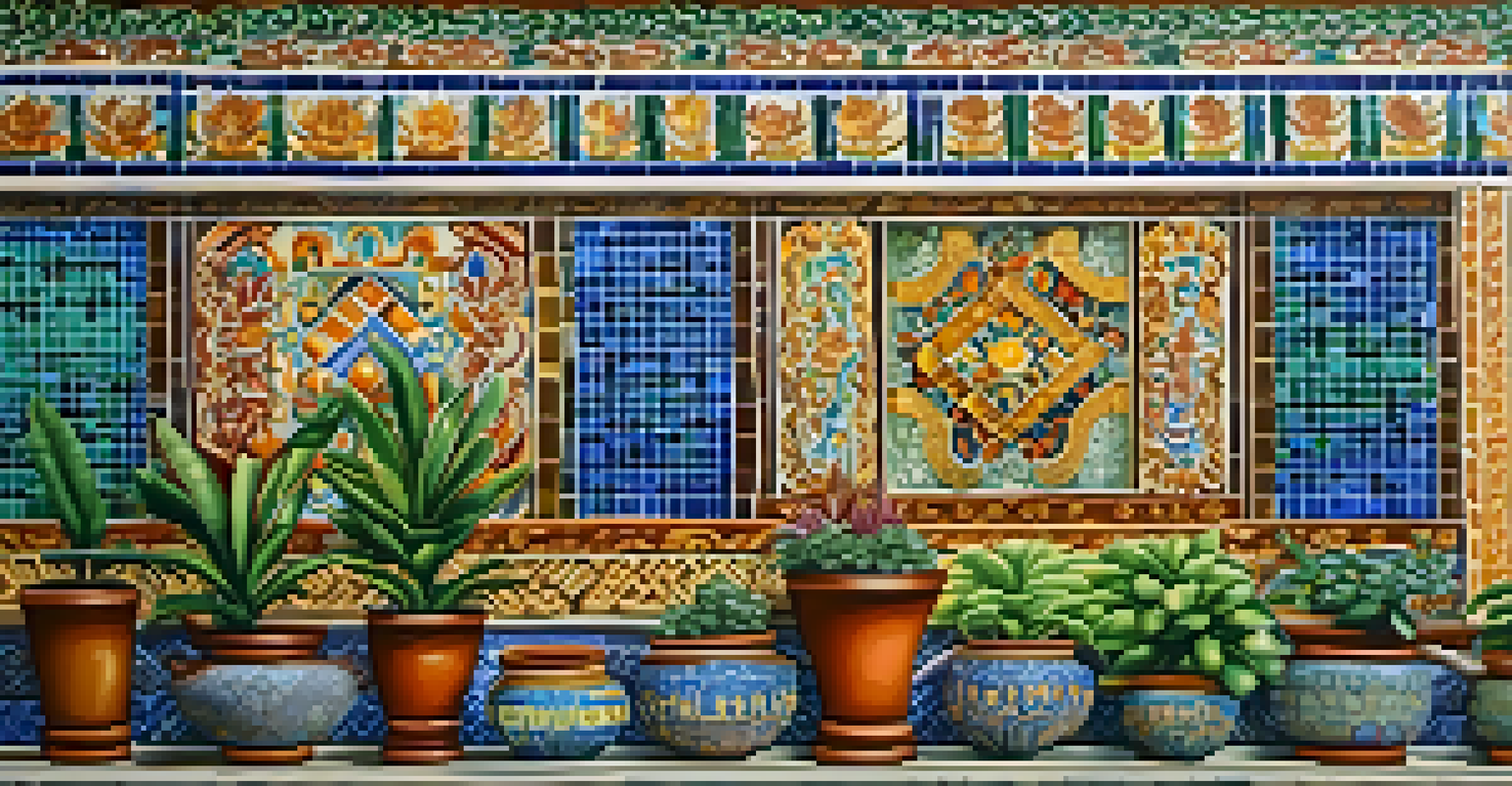Understanding the Materials Used in Thai Architecture

The Role of Wood in Traditional Thai Structures
Wood has always been a crucial element in traditional Thai architecture, celebrated for its beauty and versatility. Structures like temples and houses often showcase intricate wooden carvings that reflect Thai artistry. The use of local hardwoods, such as teak, not only provides durability but also adds warmth to the atmosphere of these buildings.
Architecture is the thoughtful making of space.
Moreover, wood is favored for its sustainability; it is a renewable resource that can be sourced locally, reducing the environmental impact. The craftsmanship involved in shaping wood into ornate details brings communities together, as these techniques have been passed down through generations. This connection to nature and heritage is a vital aspect of Thai architectural identity.
However, wood's susceptibility to pests and weathering means that proper maintenance is essential. Traditional builders have developed techniques over centuries to preserve wood, ensuring that these structures endure through time. This careful balance between beauty and practicality is what makes wood a beloved material in Thai architecture.
Incorporating Stone in Thai Temples and Shrines
Stone plays a significant role in the construction of temples and shrines across Thailand, symbolizing permanence and strength. The use of sandstone and laterite is prevalent, as these materials are both locally sourced and highly durable. They allow for the creation of intricate details, from statues to decorative elements that adorn these sacred spaces.

The process of quarrying and shaping stone is labor-intensive, often involving skilled artisans who have honed their craft over many years. This dedication to craftsmanship is evident in the beautiful carvings that tell stories of Buddhist teachings and local folklore. These stone sculptures not only enhance the aesthetic appeal but also serve as cultural markers of identity.
Wood's Vital Role in Thai Architecture
Wood is cherished for its beauty, sustainability, and the craftsmanship that connects communities to their heritage.
Additionally, stone structures provide a cool respite in Thailand's tropical climate, making them practical as well as beautiful. The coolness of stone contrasts with the heat, creating a serene environment for worship and reflection. This harmony between function and form is a hallmark of Thai architectural philosophy.
The Use of Brick in Thai Architecture
Brick is another essential material in Thai architecture, providing strength and stability to buildings. Traditionally, bricks were made from clay and fired in kilns, resulting in a sturdy and weather-resistant product. Many historical structures, such as temples and palaces, have been constructed using this material, showcasing its long-lasting qualities.
The essence of architecture is not the form but the spirit that dwells within.
The distinctive red hue of traditional Thai bricks adds a unique charm to buildings, complementing the vibrant colors often used in decorations. Furthermore, brick allows for greater flexibility in design, enabling architects to create intricate patterns and textures that enhance the visual appeal of structures. The combination of aesthetics and durability makes brick a favored choice in Thai architecture.
In recent years, there has been a resurgence in using brick, as architects seek to blend modern techniques with traditional materials. This fusion not only preserves the cultural heritage but also creates a dialogue between the old and the new. The continued use of brick in contemporary designs highlights its timeless appeal and relevance in today's architectural landscape.
Bamboo: A Sustainable Choice in Thai Design
Bamboo is gaining popularity in Thai architecture, especially in eco-friendly designs. Known for its rapid growth and strength, bamboo is a sustainable alternative to traditional building materials. It can be used for everything from structural supports to decorative elements, showcasing its versatility in various applications.
The lightweight nature of bamboo makes it easy to work with, allowing for creative designs that are both functional and visually striking. Its natural aesthetic blends seamlessly with the tropical environment, promoting harmony between architecture and nature. This connection is vital in Thai culture, where the natural world is deeply revered.
Embracing Modern Materials
Modern innovations like steel and glass are being integrated with traditional Thai elements to create functional and aesthetically pleasing structures.
Moreover, bamboo structures can be constructed quickly, making them an attractive option for both residential and commercial projects. As awareness of sustainability grows, architects are increasingly incorporating bamboo into their designs, paving the way for innovative and responsible building practices. This shift not only honors Thai traditions but also advocates for a greener future.
Ceramics and Tiles: Colorful Expressions in Thai Architecture
Ceramics and tiles add a vibrant splash of color to Thai architecture, often seen in temples and traditional homes. These materials are used for decorative purposes, with intricate patterns and glazes that reflect the rich cultural heritage of Thailand. The craftsmanship involved in creating these ceramics is a testament to the artistry that defines Thai architecture.
Tiles, particularly the iconic glazed ones, provide not only beauty but also functionality, helping to cool surfaces and prevent heat buildup. The use of colorful tiles can create stunning mosaics that capture the attention of visitors and locals alike. This visual storytelling through ceramics is a hallmark of Thai architectural design, allowing for personal expression within the structures.
Incorporating ceramics into buildings also highlights the importance of local craftsmanship, as many artisans specialize in this art form. By supporting these crafts, architects contribute to the preservation of traditional skills and cultural identity. The use of ceramics and tiles is not just about aesthetics; it is about telling a story and celebrating heritage.
The Significance of Natural Elements in Thai Architecture
Natural elements like water, plants, and stone are integral to Thai architecture, creating serene environments that enhance spiritual experiences. Water features, such as ponds and fountains, are commonly found in temple complexes, symbolizing purity and tranquility. They not only serve a decorative purpose but also provide cooling effects in the humid climate.
Landscaping with native plants also plays a crucial role in design, promoting biodiversity and sustainability. Gardens surrounding buildings often reflect the natural beauty of Thailand's landscapes, creating a seamless transition between the built and natural environments. This integration fosters a sense of peace and harmony, essential in Thai culture.
Natural Elements Enhance Design
Incorporating natural elements like water and plants fosters serenity and harmony, crucial to the spiritual experience in Thai architecture.
Moreover, the thoughtful placement of natural elements encourages mindfulness and reflection. Spaces designed with nature in mind invite visitors to pause and connect with their surroundings. This philosophy is woven into the very fabric of Thai architecture, emphasizing the importance of balance between human-made structures and the natural world.
Modern Innovations in Thai Architectural Materials
As Thailand embraces modernization, new materials and technologies are emerging in the architectural landscape. Innovations such as steel and glass are being incorporated into designs, allowing for sleek, contemporary aesthetics. These materials offer durability and flexibility, enabling architects to push the boundaries of traditional forms.
While modern materials provide exciting possibilities, many architects are committed to blending these innovations with traditional Thai elements. This fusion creates buildings that honor cultural heritage while meeting the demands of contemporary living. The use of modern materials does not mean abandoning tradition; rather, it enhances and evolves it.

Furthermore, sustainable practices are becoming a priority in modern Thai architecture, with a focus on energy efficiency and minimal environmental impact. Architects are exploring options like green roofs and solar panels, integrating these technologies with local materials. This forward-thinking approach ensures that Thai architecture continues to thrive in a rapidly changing world.